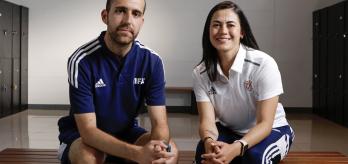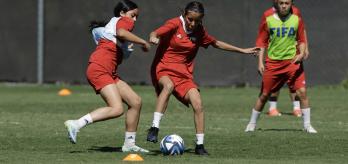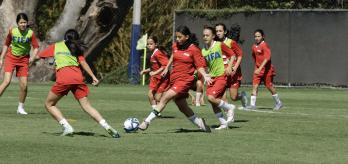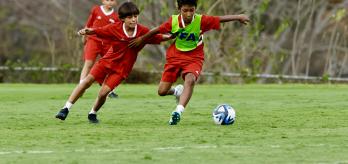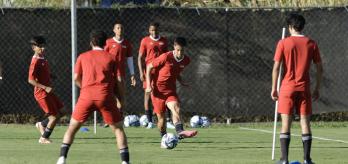Precise combination play is required to bypass defenders and work the space to play a long pass. In this scenario, wide players are tasked with timing their runs to perfection, while ball carriers must play perfectly weighted passes. Finally, crosses must hit the space behind defenders and be delivered as team-mates break into the penalty area.
In this session, FIFA Talent Coach Claudio García and Costa Rican Football Association (FCRF) Talent Coach Lina Arana deliver a series of exercises that focus on combination play and crossing to a group of girls. The session gets under way with a passing circuit that activates the players to work on combination play and finishing. The second exercise builds on the combinations worked on in the previous exercises and introduces a wide player who delivers a cross. This is followed by a 3v1 rondo that leads into crossing and finishing, and the session is rounded off with a 6v6 plus 3 small-sided game that puts all of the principles acquired in the previous exercises into practice in real-game scenarios
Session overview
Key coaching points
-
Making well-timed runs and playing correctly weighted passes can influence the quality of combination play.
-
Players should look to play first-time crosses that take advantage of the space behind the opposition’s backline.
-
Central players should play on the half-turn and adopt an open body shape to enable them to find wide players quickly and effectively.
-
Attacking players must think ahead and anticipate the cross by sprinting into the penalty area as the pass is played towards the wide player.
-
Players should time their runs to attack the cross. If they go too early, they may end up in an unfavourable position to finish on goal.
Part 1: passing circuit
This passing drill focuses on a unit scale and aims to introduce players into the session by working on passing ranges and combination play. The exercise involves various three-player passing sequences, all of which end with the player closest to the mini-goal passing the ball into the goal.
-
Mark out four 35m x 10m exercise areas side by side.
-
Place a mini-goal at the end of each exercise area.
-
Lay out cones inside each exercise area, as displayed in the graphic above.
-
Allocate 3 or 4 players to each exercise area.
-
In each exercise area, place a player at each of the 3 stations shown in the graphic above.
-
The exercise begins with the player positioned at the opposite side of the exercise area to the mini-goal in possession.
-
Players perform various passing combinations to progress the ball towards the mini-goal.
-
Players can drop to receive the ball in front of their station or make runs to receive the ball beyond their station.
-
Once the ball is transferred beyond the station located at the side of the exercise area nearer to the mini-goal, players finish the sequence by passing the ball firmly into the mini-goal.
-
After a set period of time, players rotate groups to give them the chance to perform the sequence in both directions.
-
Set a time limit to complete the circuit.
-
Apply the offside rule.
-
Increase the passing distance to the mini-goal.
-
Create a competition between the groups in which the highest-scoring team are the winners.
-
Firm, precise passes played to the receiver’s back foot aid the fluidity of the sequence.
-
Encourage the players to play one- or two-touch to improve the efficiency of their actions.
-
Players must time their runs so that they receive the ball on the move or half-turn.
-
Players should play firm passes into the mini-goal, as if they were playing a pass into an attacker to finish.
Part 2: Combinations and crossing
The passing sequences involved in this exercise work on a unit scale and focus on passing combinations between central, wide and forward players. Players are asked to complete a passing sequence before finishing into the mini-goals.
-
Mark out two 40m x 25m exercise areas in 1 half of a full-size pitch.
-
Place 2 mini-goals on the right side at the end of one of the exercise areas.
-
Place 2 mini-goals on the left side at the end of the other exercise area.
-
Mark out the stations A, B and C like shown in the graphic above.
-
Split the players into 2 groups of 7.
-
Position 2 players at station B, 2 players at station C and 3 players at station A.
-
The exercise begins with the player at A (“A”) in possession.
-
A plays a pass to B.
-
B passes to C.
-
C lays the ball off to the onrushing A.
-
A plays a pass into the space in front of B.
-
A sprints towards the mini-goals.
-
C jogs towards the mini-goals.
-
B latches onto A’s pass and delivers a first-time cross towards either A or C.
-
A or C finishes first-time into either of the 2 mini-goals.
-
A passes to C.
-
C lays the ball off to B.
-
B plays a one-two with A.
-
B latches onto A’s pass and delivers a first-time cross towards either A or C.
-
A or C finishes first-time into either of the 2 mini-goals.
-
A should play a firm, well-weighted pass into B’s path to avoid them having to break their stride and to help them to deliver an accurate cross.
-
Firm and accurate passes aid the fluidity of the sequence.
-
Immediately after playing the ball to B, A must sprint towards the mini-goals to meet B’s cross, while C must hold their run and anticipate the cross.
-
Coordinating the timing of their runs helps players to execute actions efficiently.
Part 3: 3v1 rondo and cross to finish
This drill focuses on unit-level actions in attack. The exercise simulates an attacking scenario in which the attacking team play a long ball out wide behind the opposition’s defence for a wide player to deliver a cross for players arriving from deep.
-
Use 1 half of a full-size pitch as the exercise area.
-
Position a full-size goal at one end of the exercise area.
-
Place a goalkeeper in the goal.
-
Mark out a 10m x 15m area in which the side furthest from the goal lies centrally on the halfway line.
-
Place a cone on each flank, 10m from the 2 corners of the 10m v 10m area that are nearer to the goal.
-
Walk 15m from each side of the penalty area and place 2 mannequins 5m apart, angled towards the 10m v 10m area.
-
Set up a 3v1 scenario inside the 10m x 10m area.
-
Position 2 players at each wide cone.
-
Place 4 defenders beside the goal (2 beside each goalpost).
-
The exercise begins with a 3v1 (oranges v. blue) rondo inside the 10m v 15m area.
-
The 3 oranges try to keep the ball and aim to complete 4 passes.
-
The blue player tries to dispossess the oranges.
-
Once the oranges have completed 4 passes, the orange-team player who receives the 4th pass plays a long pass outside, inside or preferably over the 2 mannequins on either side of the exercise area.
-
Before the long pass is played, the player stationed at the wide cone sets off to run into the space beyond the mannequins.
-
As soon as the long pass is played, the 3 orange-team players sprint from the rondo area towards the penalty area.
-
The blue defender sprints from the rondo area towards the penalty area and is joined in the penalty area by a team-mate who enters the exercise area from their position beside the goal.
-
The wide player delivers a cross for the 3 orange-team players to attack, whilst the blue player who entered the exercise area from beside the goal tries to cut out the cross, and their team-mate defends the goal.
-
The long pass played from deep should be firm and accurate.
-
Attacking players should use the mannequins as a guide for where the pass is to be played.
-
Attacking players must recognise when the long pass is played and immediately sprint towards the penalty area.
-
When contesting the 3v1 rondo, attacking players should be aware and adopt the right body shape in readiness to play the long pass.
-
Attacking players should make intelligent runs into the penalty area that cater for all possible crossing scenarios.
Part 4: 6v6 plus 3 small-sided game
This small-sided game focuses on a team level and puts the attacking principles worked on in the previous exercises into practice. The in-possession team are asked to work the ball into the wide zones before attacking the cross.
-
Mark out a 30m x 40m exercise area.
-
Split the exercise area into a central area and 2 wide zones.
-
Position a full-size goal at either end of the exercise area.
-
Place a goalkeeper in each goal.
-
Divide the players into 2 teams of 6 (blues and oranges) and 1 group of 3 (greys), who acts as neutral players.
-
Set up a 6v6 (blues v. oranges) inside the central area.
-
Position the 3 grey players as follows: 1 inside the central area and 1 in either wide zone.
-
The exercise begins with 1 of the goalkeepers in possession.
-
The blues attack the oranges’ goal with the support of the 3 neutral players, who create a 9v6 overload.
-
The oranges cannot enter the wide zones occupied by the neutral players.
-
The oranges try to win the ball and attack the blues’ goal. If they manage to do so, the teams immediately swap roles.
-
When there is space behind the opposition’s defence, the in-possession team should play the ball to the wide neutral players and attack the penalty area in readiness to meet a cross.
-
The in-possession team should look to deliver first-time crosses that may catch the opposition’s defence out of position.
-
The wide neutral players should focus on delivering well-placed, driven crosses that hit the area between the goalkeeper and defenders and are in coordination with the attackers’ runs.





